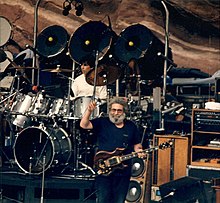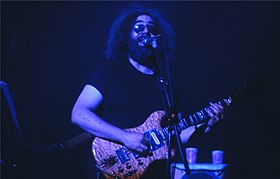Jerry Garcia
[18][19] Shortly before Clifford's birth, their father and a partner leased a building in downtown San Francisco and turned it into a bar, partly in response to Jose being blackballed from a musicians' union for moonlighting.
[17] Blair Jackson, who wrote Garcia: An American Life, notes that a local newspaper article describing Jose's death did not mention Jerry being present when he died.
[44] Consequently, in 1959, Garcia's mother again moved the family to a safer environment, to Cazadero, a small town in Sonoma County, 90 miles (140 km) north of San Francisco.
[60] In 1962, Garcia met Phil Lesh, the eventual bassist of the Grateful Dead, during a party in Menlo Park's bohemian Perry Lane neighborhood (where author Ken Kesey lived).
[62] The link between KPFA and the Grateful Dead continues to this day, having included many fundraisers, interviews, live concert broadcasts, taped band performances and all-day or all-weekend "Dead-only" marathons.
"[23] In 1965, Mother McCree's Uptown Jug Champions evolved into the Warlocks, with the addition of Dana Morgan, Jr. (soon replaced by Phil Lesh) on bass guitar and Bill Kreutzmann on percussion.
[6] Often, Garcia would take cues from rhythm guitarist Bob Weir, remarking that "there are some [...] kinds of ideas that would really throw me if I had to create a harmonic bridge between all the things going on rhythmically with two drums and Phil [Lesh's] innovative bass playing.
There was also early rock (like Lonnie Mack, James Burton, and Chuck Berry), contemporary blues (Freddie King and Lowell Fulsom), country and western (Roy Nichols and Don Rich), and jazz (Charlie Christian and Django Reinhardt) to be heard in Garcia's style.
Among these were lead lines based on rhythmic triplets (examples include the songs "Good Morning Little School Girl", "New Speedway Boogie", "Brokedown Palace", "Deal", "Loser", "Truckin'", "That's It for the Other One", "U.S. Blues", "Sugaree", and "Don't Ease Me In").
After several years of producing stories on the Grateful Dead and band members' side projects, Hamilton interviewed Bob Weir for a feature on Garcia's death marking the end of an era.
Garcia spent a lot of time in the recording studio helping out fellow musician friends in session work, often adding guitar, vocals, pedal steel, sometimes banjo and piano and even producing.
He played on over 50 studio albums, the styles of which were eclectic and varied, including bluegrass, rock, folk, blues, country, jazz, electronic music, gospel, funk, and reggae.
Others include Tom Fogerty, David Bromberg, Robert Hunter (Liberty, on Relix Records), Paul Pena, Peter Rowan, Warren Zevon, Country Joe McDonald, Pete Sears, Ken Nordine, Ornette Coleman, Bruce Hornsby, Bob Dylan, It's a Beautiful Day, and many more.
Garcia also played pedal steel guitar for fellow-San Francisco musicians New Riders of the Purple Sage from their initial dates in 1969 to October 1971, when increased commitments with the Dead forced him to opt out of the group.
In 1988, Garcia agreed to perform at several major benefits including the "Soviet American Peace Walk" concert at the Band Shell, in Golden Gate Park, San Francisco, that drew 25,000 people.
Garcia also played with Nick Gravenites and Pete Sears at a benefit given for Vietnam Veteran and peace activist Brian Willson, who lost both legs below the knee when he attempted to block a train carrying weapons to military dictatorships in El Salvador.
Garcia was an early adopter of digital art media; his artistic style was as varied as his musical output, and he carried small notebooks for pen and ink sketches wherever he toured.
Garcia's artwork has since expanded into everything from hotel rooms, wet suits, men's sport shirts, a women's wear line, boxer shorts, hair accessories, cummerbunds, silk scarves and wool rugs.
In the midst of a March 1973 Grateful Dead engagement at Long Island's Nassau Coliseum, Garcia met Deborah Koons, an aspiring filmmaker from a wealthy Cincinnati, Ohio-based family who would much later marry him and become his widow.
[110] Grateful Dead members Phil Lesh, Bob Weir, and Ron "Pigpen" McKernan were apprehended on marijuana charges which were later dropped, although Garcia himself was not arrested.
Influenced by the stresses of creating and releasing The Grateful Dead Movie and the acrimonious collapse of the band's independent record labels over the next two years, Garcia became increasingly dependent upon both substances.
Precipitated by an unhealthy weight, dehydration, bad eating habits, and a recent relapse on the Grateful Dead's first stadium tour, Garcia collapsed into a diabetic coma in July 1986, waking up five days later.
Inspired by Garcia's improved health, a successful album and the continuing emergence of Mydland as a third frontman, the band's energy and chemistry reached a new peak in the late 1980s.
[130] On the morning of April 4, 1996, after a total lunar eclipse earlier that day, Weir and Deborah Koons, accompanied by Sanjay Mishra, spread half of Garcia's ashes into the Ganges at the holy city of Rishikesh, India,[131][132][133] a site sacred to Hindus.
During Garcia's "pedal steel flirtation period" (as Bob Weir referred to it in Anthem to Beauty), from approximately 1969 to 1972, he initially played a Fender instrument before upgrading to the ZB Custom D-10,[136] especially in his earlier public performances.
Due to the ongoing repair and retrofitting of other instruments, Garcia played Tiger during the last song ("Box of Rain") of his final performance with the Grateful Dead at Chicago's Soldier Field on July 9, 1995.
[170] The concert featured Bob Weir, Bill Kreutzmann, Mickey Hart, Bruce Hornsby, Trey Anastasio, Warren Haynes, Jimmy Herring, Michael Kang, Jay Lane, Jeff Chimenti, Mark Karan, Robin Sylvester, Kenny Brooks, Melvin Seals, Merl Saunders, Marty Holland, Stu Allen, Gloria Jones, and Jackie LaBranch.
Seattle rock band Soundgarden wrote and recorded the instrumental song "Jerry Garcia's Finger", dedicated to the singer, which was released as a b-side with their single "Pretty Noose".
The production was directed and choreographed by Rachel Klein, featured a book by Michael Norman Mann, had Jeff Chimenti serving as music supervisor, and was performed at the Minetta Lane Theatre in New York City.
[177] On November 18, 2021, it was announced Jonah Hill would portray Garcia in a forthcoming Grateful Dead biopic written by Scott Alexander and Larry Karaszewski directed by Martin Scorsese for Apple TV+.



